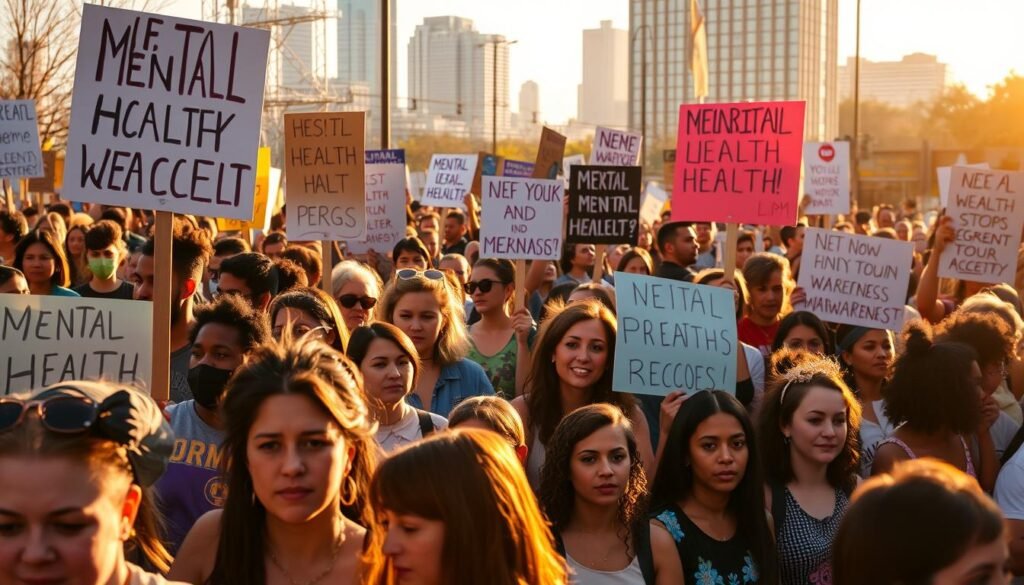Talking about mental health is more important than ever. It’s key to create a safe space where people can share their feelings and get help. The National Institute of Mental Health says almost one in five adults in the U.S. deals with mental illness each year.
This shows we need more awareness and open talks. By talking openly about mental health, we can build a more caring society. It’s all about understanding and supporting each other.
Key Takeaways
- Open discussions about mental health help in breaking the stigma.
- Almost 20% of U.S. adults face mental health challenges yearly.
- Mental health awareness is crucial for community support.
- Sharing experiences fosters understanding and compassion.
- Improving conversations can lead to better access to resources.
Understanding Mental Health and Its Importance
Mental health is key to our overall well-being. It includes our emotional, psychological, and social health. It shapes how we think, feel, and act. Knowing about mental health helps us spot common issues and support each other better.
What is Mental Health?
Mental health is about our mind and emotions. It helps us deal with stress, connect with others, and make choices. Good mental health is crucial for daily life and helps us face challenges.
Common Mental Health Issues
Many people in the U.S. face common mental health problems. These include anxiety, depression, and bipolar disorder. The National Alliance on Mental Illness says about 1 in 5 adults have mental illness. Talking about these issues can help us understand and support each other more.
The Impact of Mental Health on Daily Life
Mental health affects more than just us. It impacts our relationships, work, and life quality. Poor mental health can harm our personal and professional lives. But good mental health builds resilience and helps us cope with tough times. So, promoting mental health is good for us and society.
The Stigma Surrounding Mental Health
The stigma around mental health has roots in history, shaped by society and culture. Knowing where this stigma comes from helps us understand today’s views. In the past, people saw mental illness as a sign of being possessed or morally weak. These old ideas still affect us today, making it key to tackle them.
Historical Context of Mental Health Stigma
For centuries, those with mental health issues were shunned and isolated. Ancient societies blamed mental disorders on spirits. This led to harsh treatment and locking people away. Even with the Enlightenment’s progress, old beliefs stuck around.
Into the 20th century, many saw mental illness as a personal failing, not a medical problem. This view still fuels stigma today.
Common Misconceptions
Many misconceptions add to mental health stigma. Some think mental illness shows personal weakness, as if people just need to be tougher. Others believe recovery is impossible or that treatments don’t work. These beliefs stop people from seeking help and make those with mental health issues seem less capable or worthy.
Why Stigma Persists Today
To understand why stigma stays, we must look at culture and misinformation. Despite more awareness, stigma lingers because of a lack of understanding and education. Cultural norms and stereotypes also play a big role in keeping mental health issues hidden.
Fear, shame, and not understanding mental health science also keep stigma alive today.
The Benefits of Discussing Mental Health
https://www.youtube.com/watch?v=tPZzRMnhxlU
Talking openly about mental health has many benefits. It helps both individuals and communities. By talking about mental health, we can raise awareness and create a supportive space.
Creating Awareness and Understanding
When we talk more about mental health, we learn more about it. This knowledge helps us fight off stigma and myths. It also helps us spot mental health issues early, leading to better support and understanding.
Encouraging Early Intervention
Talking about mental health early can make a big difference. Studies show it leads to quicker help and better results. Early talks help people get the help they need before things get worse.
Fostering Community Support
Building a strong community support network is key for mental health. By sharing our stories, we connect with others. This connection helps us feel less alone and shows the value of community in mental health.
Personal Stories: The Power of Sharing
Personal stories can deeply affect how we talk about mental health. By sharing their own battles, people weave a rich fabric of experiences. This fabric not only connects us but also helps break down mental health stigmas.
Real-Life Experiences of Mental Health Struggles
Stories about mental health struggles show the many ways people face challenges. From beating anxiety to dealing with depression, these tales are common. They remind us we’re not alone, offering comfort and understanding.
Sharing these stories can inspire others to open up about their own struggles. It encourages them to seek help or share their own tales.
How Sharing Stories Can Inspire Change
Sharing personal stories can spark change in society. These stories of resilience help us accept mental health issues more. As people talk openly about their struggles, stigma fades.
This openness leads more people to seek help. They feel empowered to share their own stories. The power of these stories lies in the connections they create, leading to more empathetic talks about mental health.
The Role of Social Media in Mental Health Discourse
Social media is key in spreading mental health conversations. It lets people share their stories, creating a sense of community. These platforms connect people, making discussions more diverse and inclusive.
Campaigns and hashtags on social media encourage honest talks about mental health. They build online communities that support open discussions.
| Social Media Platform | Key Features | Influence on Mental Health Discourse |
|---|---|---|
| Visual storytelling, hashtags, community support | Encourages sharing experiences through images and captions | |
| Short messages, trending topics, quick engagement | Allows rapid discussions and sharing of resources | |
| Groups, events, personal stories | Fosters community building and support groups | |
| TikTok | Short videos, trends, creative expression | Engages younger audiences in authentic storytelling |
Strategies for Opening the Conversation
Talking about mental health can be tough but it’s key for understanding and support. Starting these conversations means making a space where people feel safe to share. Good tips for talking can help a lot. Listening well is also super important, as it makes people feel heard and valued.
Starting the Discussion: Tips and Techniques
Starting a mental health talk can be done in a thoughtful way. Here are some good strategies:
- Use “I” statements to share your feelings and views, which can make others less defensive.
- Ask questions that need more than just a yes or no answer.
- Share your own stories to show you’re open and brave.
- Pay attention to your body language and tone to make the space welcoming.
Creating Safe Spaces to Talk
Creating a safe space is key for open talks. Think about these things:
- Make sure the place is private so people feel safe sharing.
- Be non-judgmental to build trust.
- Validate feelings and experiences without being dismissive.
- Give people time to share their thoughts fully.
How to Listen Effectively
Listening well is crucial in mental health talks. Here’s how to do it better:
- Give the speaker your full attention, avoiding distractions.
- Reflect back what they say to show you’re actively listening.
- Show you’re engaged and empathetic with your body and words.
- Let the speaker finish before you respond.
Using these tips can help a lot in starting open talks about mental health. It can lead to stronger bonds and better understanding.
Mental Health in the Workplace

It’s important to understand the role of mental health in the workplace. A supportive environment helps employees feel better, leading to less time off and better moods. Good mental health policies can help employees deal with job stress.
The Importance of Supportive Work Environments
A supportive work environment encourages open communication and teamwork. Companies that focus on mental health make employees feel valued and heard. This reduces stigma and boosts team performance.
Policies That Promote Mental Wellbeing
Good mental health policies are key to supporting employees. Companies can offer Employee Assistance Programs (EAPs), mental health days, and flexible work hours. These help employees manage stress and personal challenges.
Addressing Burnout and Stress
Burnout and stress are common in many workplaces. It’s important to address these issues with strategies. Companies can provide stress management workshops, encourage breaks, and support work-life balance. This leads to better productivity and happiness among employees.
| Strategy | Description | Impact |
|---|---|---|
| Employee Assistance Programs (EAPs) | Confidential counseling and support services for employees | Improved mental health and reduced absenteeism |
| Mental Health Days | Designated days off specifically for mental health | Higher employee morale and increased productivity |
| Flexible Work Arrangements | Options for remote work or adjusted hours | Enhanced work-life balance and reduced stress |
Professional Help: When to Seek It
Knowing when to seek professional help is key for mental health. Some signs show it’s time to get help, like feeling really upset or things getting worse. Spotting these signs helps people take action to get better.
Identifying When to Get Help
Feeling overwhelmed, anxious, or acting differently might mean it’s time for help. Other signs include:
- Not being able to handle daily tasks
- Stepping back from friends and family
- Using drugs or unhealthy ways to cope
- Thinking about harming oneself or suicide
Getting help early can lead to better treatment and a healthier life.
Types of Mental Health Professionals
There are many mental health professionals to help. Here are some common ones:
- Psychologists: They help figure out and treat mental health issues through talking and therapy.
- Psychiatrists: These are doctors who treat mental health problems and might prescribe medicine.
- Counselors: They help with specific problems like grief, stress, or relationship issues through talking therapy.
- Social workers: They offer therapy and help find community resources to improve life quality.
Knowing about these professionals helps find the right help for you.
How to Find the Right Therapist
Finding the right therapist is important for good mental health care. Here’s how to find one:
- Know what you need and what kind of therapy you prefer.
- Look up local therapists in directories or from people you trust.
- Have a first meeting to talk about your issues and see if you click.
- Ask about their methods, experience, and how they can help you.
- See how you feel after a few sessions to decide if you want to keep going.
Following these steps helps find a therapist who can really help with mental health.
The Role of Education in Mental Health Awareness
Education is a key tool for raising mental health awareness. By adding mental health lessons in schools, we lay a strong foundation. This helps students understand and support each other’s mental health.
Integrating Mental Health Education in Schools
Teaching mental health in schools helps remove the stigma around mental challenges. It gives students the knowledge to handle their own mental health and help others. Schools that focus on this see better student well-being and less anxiety.
Training for Educators and Staff
It’s vital to train teachers and staff on mental health. This way, they can spot when students are struggling and help them. Regular training helps schools create a supportive environment for mental health.
Community Workshops and Outreach Programs
Community outreach is key to spreading mental health education. Workshops bring together parents, caregivers, and leaders to talk about mental health. These efforts help everyone understand mental health better and support each other.
Mental Health and Family Dynamics
It’s important to understand how mental health and family dynamics are connected. The mental health of each family member affects the whole family’s well-being. When someone struggles with mental health, it can change how everyone communicates and feels.
This change can spread through the family. Knowing this helps families support each other better and become stronger together.
The Impact of Mental Health on Families
Mental health problems can cause a lot of tension in families. Issues like anxiety or depression can lead to misunderstandings and fights. Families may feel isolated when someone is struggling.
It’s key to understand these challenges to keep family interactions healthy. This way, everyone can talk openly and feel supported.
Strategies for Family Support
Creating a supportive family environment is crucial for mental wellness. Here are some ways to do it:
- Encourage open communication: Make sure everyone feels safe to share their feelings.
- Practice active listening: Show you’re really listening and care about what they say.
- Build trust: Be consistent and always there for each other to strengthen bonds.
- Engage in family activities: Doing things together can help everyone feel closer.
Helping Children Understand Mental Health
Teaching kids about mental health is vital. It helps them understand and be empathetic. Start by explaining things in a way they can understand.
Use examples they can relate to. Encourage them to ask questions and show emotions in a healthy way. Books and videos about mental health can also help.
By teaching kids about mental health, we raise a compassionate and aware generation. This helps families support each other even more.
Cultural Perspectives on Mental Health
Mental health talks are shaped by cultural beliefs and practices. Communities have their own ways of dealing with mental health issues. This understanding helps bridge cultural gaps and improve support.
How Culture Influences Mental Health Discussions
Culture greatly affects how we see mental health. In some places, talking about mental health is still a taboo. This silence can make it hard for people to get help.
It’s important to recognize these challenges. This way, we can make mental health talks more open and inclusive.
Bridging Cultural Gaps in Mental Health Awareness
To bridge cultural gaps, we need to listen to and respect diverse voices. Programs that teach about different cultures in mental health education help a lot. They make sure everyone gets the right support for their needs.
Celebrating Diversity in Mental Health Narratives
Sharing diverse mental health stories enriches our conversations. Stories from different cultures show us what we have in common and what’s different. This approach builds empathy and improves mental health care.
Resource Allocation for Mental Health Initiatives
It’s crucial to allocate enough resources for mental health efforts. Support from governments and nonprofits is key. This funding boosts the quality and availability of mental health services.
Strong community resources are vital for mental health support. They help people get the care they need.
Government and Nonprofit Support
Government support is foundational for mental health. Local, state, and federal programs aim to provide lasting services. They reach out to many people.
Nonprofits also play a big role. They start initiatives that governments might miss. Nonprofits fill service gaps with programs that meet community needs.
Funding for Mental Health Programs
Funding for mental health comes from many places. This includes government grants, private donations, and fundraising. These funds help create and keep programs running.
Investing in mental health services is key. It ensures programs can help people all the time.
Importance of Community Resources
Community resources are vital for mental health support. They offer services like counseling and crisis help. Local groups and healthcare providers work together.
This teamwork makes mental health efforts stronger. It raises awareness and creates healthier communities for all.
Advocacy and Activism in Mental Health

Advocacy and activism are key in raising awareness and protecting the rights of those with mental health issues. By getting involved, we can change how people see mental health and the laws that affect it. There are many ways to make a difference, whether locally or nationally.
How to Get Involved
To start advocating for mental health, first learn about the issues. You can help by attending community events, volunteering, or joining groups focused on mental health. Social media is also a great way to spread the word and share ideas.
The Role of Mental Health Organizations
Groups like the National Alliance on Mental Illness and Mental Health America are vital. They offer training, policy info, and chances to join campaigns. These organizations bring people together, using their voices to push for change.
Success Stories in Mental Health Advocacy
Success stories show the power of mental health advocacy. Campaigns have led to more funding and laws that protect mental health. These stories inspire us, showing how advocacy can change the world of mental health.
Concluding Thoughts: Moving Forward Together
Looking ahead, we see the need for a space where mental health talks can grow. Awareness of mental health issues is rising. This opens doors for real change through teamwork at all levels.
Every effort, big or small, helps. Sharing personal stories and supporting groups that fight stigma are key. These actions build a strong network for those who need it.
Everyone can help shape the future of mental health talks. You can join community events, support mental health groups, or just talk openly with loved ones. Small steps can lead to big changes.
These talks are crucial for a society that values mental health. We all must keep the conversation going. By doing so, we ensure mental well-being stays a top priority.
Together, we can create a healthier world. A place where mental health is talked about openly and with care. Let’s work together to make this vision a reality.



